 THE MONACO GRAND PRIX LIBRARY BY ROY HULSBERGEN THE MONACO GRAND PRIX LIBRARY BY ROY HULSBERGEN |
|


|
Lotus |
Team Lotus - Lotus Engineering |
|
Lotus was Colin ChapmanÕs creation of a marque that has been for years a fore runner in races and innovation.
Chapman worked as a consultant for Vanwall and BRM until building the Lotus Grand Prix cars.
Until 1971 Lotus made customer racing cars and from then on it is Team Lotus that produced the cars, often together with a sponsor name. ChapmanÕs Grand prix cars are world famous, winning seven World Championships for Constructors and six World Championships for Drivers an outstanding record. As Jackie Stewart said: ŅChapman is the greatest, most creative designer of racing cars in the history of motor racingÓ
After Colin Chapman suddenly died in 1982, leaving behind a legacy of technical innovation, Team Lotus continued under Peter Warr, with a brief spell with Wolf and Fittipaldi.
Lotus was for a long time associated with Players, until in 1986 Lotus was on the track in bright yellow Camel colours.
It was Lotus that brought active suspension to racing and for a while with success.
After 1988 things did not go so well and the Chapman family took the reigns again, seconded by Tony Rudd as Executive Chaiman.
Lotus
GPÕs contested: 490 1958 till 1994
Pole positions: 107
Victories: 79
Fastest lap: 71
World Championship for Constructors points
1958 |
6th |
3pts |
1976 |
4th |
29pts |
1959 |
4th |
5 |
1977 |
2nd |
62 |
1960 |
2nd |
32 |
1978 |
1st |
86 |
1961 |
2nd |
32 |
1979 |
4th |
39 |
1962 |
2nd |
36 |
1980 |
5th |
14 |
1963 |
1st |
54 |
1981 |
7th |
22 |
1964 |
3rd |
37 |
1982 |
6th |
30 |
1965 |
1st |
54 |
1983 |
7th |
12 |
1966 |
5th |
18 |
1984 |
3rd |
47 |
1967 |
2nd |
50 |
1985 |
3rd |
71 |
1968 |
1st |
62 |
1986 |
3rd |
58 |
1969 |
3rd |
47 |
1987 |
3rd |
64 |
1970 |
1st |
59 |
1988 |
4th |
23 |
1971 |
5th |
21 |
1989 |
6th |
15 |
1972 |
1st |
61 |
1991 |
9th |
3 |
1973 |
1st |
92 |
1992 |
5th |
13 |
1974 |
4th |
42 |
1993 |
6th |
12 |
1975 |
7th |
9 |
|
|
|

|

The very first Lotus
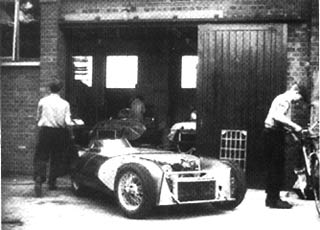
1950 workshop
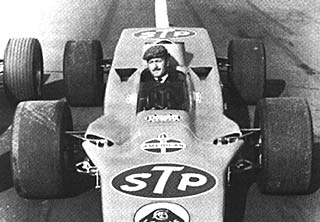
Colin Chapman in 1956
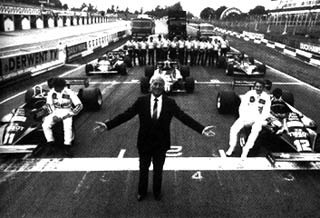
Team JPS Lotus in 1981 |
Lotus 12 - 1956/57/58
Chassis: the first single seater F2 car with front engine build around a lightweight space frame. Double wishbone front and de Dion rear suspension, but soon replaced by the Chapman strut, a hub casting, long coil spring/shock, radius arm and half shaft.
Engine: Coventry Climax FPF with 1.96, 2.0 and 2.2 litre for F1, driving a Lotus gearbox via a propshaft.
Drivers: Cliff Allison, Graham Hill
Results: 1958 6th in Monaco
|
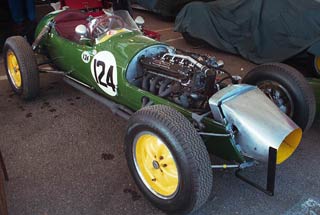 |
Lotus 16 - 1958/59
Chassis: Oval bodied, fragile lightweight space frame, suspension as the 12
Engine: Coventry Climax FPF
Drivers: Cliff Allison, Graham Hill, Innes Ireland, Rodriguez Larreta, Pete Lovely, David Piper, Alan Stacy, Mike Taylor
Results: 6th WCC 3 points, 1959 4th WCC 5 points |
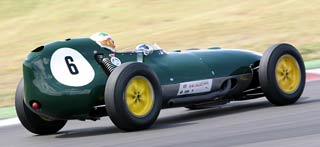 |
Lotus 18 - 1960
Chassis: First mid engined, build around a sturdier and heavier space frame. Unequal length wishbone in the front and sigle wishbone with fixed length drive shaft and twin radius rods as rear suspension.
Engine: Coventry Climax (some teams installed Vanwall, Borgward or Maserati engines)
Drivers: Cliff Allison, Lucien Bianchi, Jo Bonnier, Jim Clark, Colin Davies, Olivier Gendebien, Masten Gregory, Dan Gurney, Innes Ireland, Tony Maggs, Willy Mairesse, Tony Marsh, Stirling Moss, Tim Parnell, John Surtees, Mike Taylor, Trevor Taylor, Maurice Trintignant, etc. (128 18Õs have been produced)
Results: 2nd WCC with 32 points, first victory Moss in Monaco |
 |
Lotus 21 - 1961
Chassis: Low and slippery body, the driver was in a recklining position and fuel tanks were moved behind the driver seat. Inboard spring/shock units and outboard brakes in the rear.
Engine: Coventry Climax FPF with ZF gearbox
Drivers: Jack Brabham, Jim Clark, Innes ireland, Willy Mairesse, Stirling Moss, Jo Siffert, Trevor Taylor
Results: 2nd WCC 32 points |
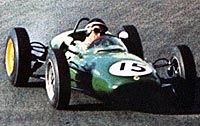 |
Lotus 24 - 1962
Chassis: Improved 21 space frame
Engine: 7 with Coventry Climax FWMV V8 and
5 with BRM V8
Drivers: Chris Amon, Peter Arundell, Jo Bonnier, Jack Brabham, Jim Clark, Paddy Driver, Masten Gregory, Mike Hailwood, Graham hill, Phil Hill, Innes Ireland, Tony Maggs, Tim Parnell, Roger Penske, Peter Revson, Wolfgang Seidel, Gunther Seifert, Jo Siffert, Trevor Taylor, Maurice Trintignant, etc.
Results: 2nd WCC 36 points |
 |
Lotus 25 - 1963/64
Chassis: introduction of monocoque construction, twin side pontoons in alloy linked with steel bulkheads. Just under 30kg with good stiffness. Suspension from the 24
Engine: Coventry Climax FWMV with ZF gearbox and BRM V8 with Hewland gearbox
Drivers: Jim Clark (World Champion), Chis Amon, Peter Arundell, Richard Attwood, Bob Bondurant, Jo Bonnier, Piers Courage, Mike Hailwood, Paul Hawkins, Innes Ireland, Tony Maggs, Pedro Rodriguez, Mike Spence, Trevor Taylor.
Results: 1963 1st WCC 54 points, 1964 3rd WCC 37 points, |
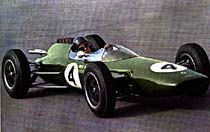 |
Lotus 33 - 1965/66
Chassis: a development on the 25 with modified suspension for the wider Dunlop tyres
Engine: 2 litre 32 valve Climax V8 and 2.1 litre BRM V8
Drivers: Jim Clark (World Champion), Peter Arundell, Paul Hawkins, Graham Hill, Pedro Rodriguez, Mike Spence
Results: 1st WCC 54 points, 1966 5th WCC 18 points |
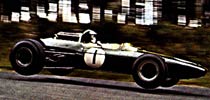 |
Lotus 49 - 1967/68/69
Chassis: Body painted in Gold Leaf Team Lotus which shocked the motor world.
A car that set a new standard in GP racing. Monocoque construction where the engine was bolted on the bulkhead behind the driver and made an intregral bearing part. The rear suspension subframe was bolted onto the engine block and thin radius arms to carry loads into the cockpit.
Engine: Ford Cosworth 3 litre DFV. Chapman was instumental for bringing Duckworth, Copp and Hayes together to develop the DFV engine. Exclusive for the 67 season for Lotus.
Drivers: Mario Andretti, Richard Attwood, Jo Bonnier, Jim Clark (died in a 49), Emmerson Fittipaldi (first F1 race), Wilson fittipaldi, Graham Hill (World Champion in a 49), Pete Lovely, Jackie Oliver, Jochen Rindt, Jo Siffert.
Results: 1967 2nd WCC 50 points, 1968 1st WCC 62 points, 1969 3rd WCC 47 points |
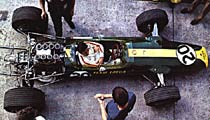 |
Lotus 72 - 1970/71/72/73/74/75
Chassis: After a not successfull tryout with the 63 four wheel drive car, the 72 was to be the longterm successor of the 49. A fine wedge shape monocoque from metal and fiberglass, ultra low with midship radiators. Inboard brakes reducing suspension loads. Various wing set ups were used.
As from 72 the cars were in John Player Special colours
Engine: Ford Cosworth DFV
Drivers: Dave Charlton, Jim Crawford, Emmerson Fittipaldi (72 World Champion), Brian Henton, Graham Hill, Jacky Ickx, Eddie Keijan, John Miles, Ronnie Peterson, Jochen Rindt, Jody Scheckter, Tim Schenken, Tony Trimmer, Dave Walker, John Watson, Reine Wisell
Results: 1970 1st WCC 59 points, 1971 5th WCC 21 points, 1972 1st WCC 61 points, 1973 1st WCC 92 points, 1974 4th WCC 42 points, 1975 7th WCC 9 points |
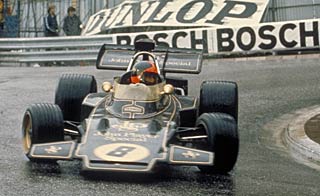 |
Lotus 78 - 1976/77
Chassis: The JPS Mk III was a remarkable ground effects car. A sandwich monocoque with radiators and fuel tanks in the side pods, an inverted rear wing and a ŌskirtÕ all around.
Engine: Ford Cosworth
Drivers: Mario Andretti, Gunnar Nilsson, Ronnie Peterson (died in a 78 in 1979 Italian GP), Hector Rebaque
Results: 4th WCC 29 points, 1977 2nd WCC 62 points, 1978 1st WCC 86 points |
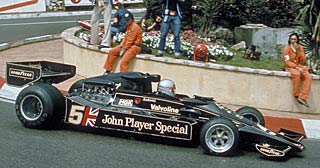 |
Lotus 79 - 1978/79
Chassis: An even more elegent refined 78 with great ground effects. The fuel tanks were moved bejond the driver and rear suspension was kept out of the airflow.
Engine: Ford Cosworth 3 litre with Hewland FG400 gearbox
Drivers: Mario Andretti (Ō78 World Champion), Jean Pierre Jarier, Ronnie Peterson, Hector Rebaque, Carlos Reutemann
Results: 1st WCC 86 points, 1979 4th WCC 39 points |
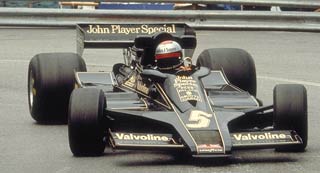 |
Lotus 81 - 1980/81
Chassis: Raced under Essex the car was an evolution of the 79 and the development of the 80. Sheet aluminium monocoque.
Evolved in to the 87 in JPS colours and the controversal 88
Engine: Ford Cosworth V8
Drivers: Mario Andretti, Elio de Angelis, Nigel Mansell
Results: 5th WCC 14 points, 1981 7th WCC 22 points |
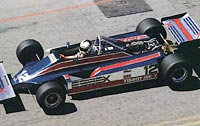 |
Lotus 91 - 1982/83
Chassis: The last Colin Chapman and Cosworth car made from carbon fibre Kevlar sandwich weighing a mere 18 kg.
It sported water cooled brakes and stiff suspension
Engine: Ford Cosworth V8
Drivers: Elio de Angelis, Nigel Mansell
Results: 6th WCC 30 points, 1983 7th WCC 12 points |
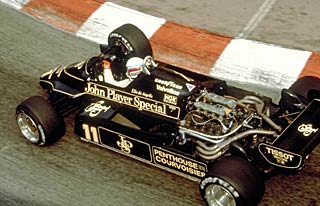 |
Lotus 94T - 1984
Chassis: The 93T was Lotus first turbo car and quickly replaced by the 94T based on the 91 tub and using hard Pirelli tyres
Engine: Renault V6 Turbo
Drivers: Elio de Angelis, Nigel Mansell
Results: 3rd WCC 47 points |
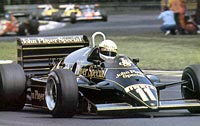 |
Lotus 95/97T - 1985
Chassis: Carbon Kevlar monocoque with pull rod suspension with good handling and return to Goodyear tyres
Engine:Renault EF15 V6 Turbo
Drivers: Elio de Angelis, Nigel Mansell
Results: 3rd WCC 71 points |
 |
Lotus 98T - 1986
Chassis: The last JPS car made of a one piece moulded carbon Kevlar monocoque. Front suspension from the 97 and a hydraulic adjustable rear suspension.
Engine: Renault EF15B V6 Turbo
Drivers: Johnny Dumfries, Ayrton Senna
Results: 3rd WCC 58 points |
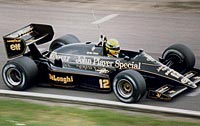 |
Lotus 99T - 1987
Chassis: Lotus now in yellow and blue Camel dress. The first F1 car to race with active suspension
Engine: Honda V6 Turbo and Lotus 6 speed gearbox
Drivers: Ayrton Senna, Satoru Nakajima
Results: 3rd WCC 64 points, Senna won in Monaco |
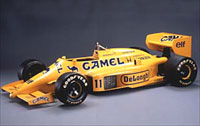 |
Lotus 100T - 1988
Chassis: A straight evolution of the 99 with a more pointed nose, allowing drivers feet to be behind the frontwheel center line. Conventional suspension
Engine: Honda V6 Turbo
Drivers: Satoru Nakajima, Nelson Piquet
Results: 4th WCC 23 points |
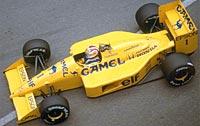 |
|
|
|